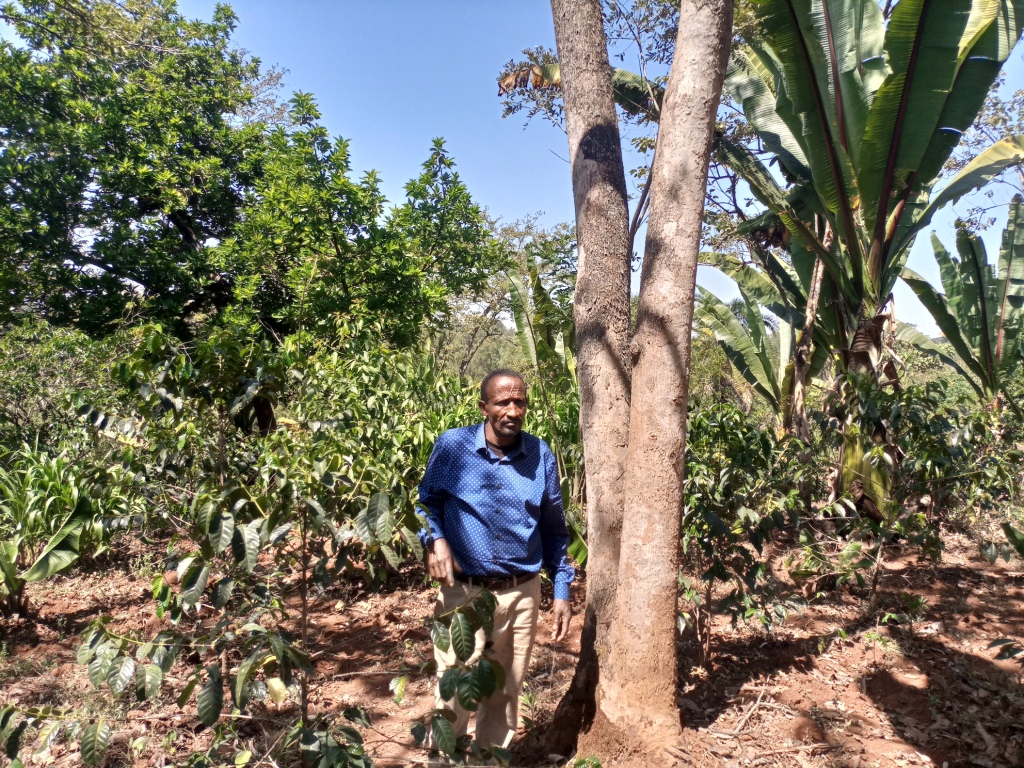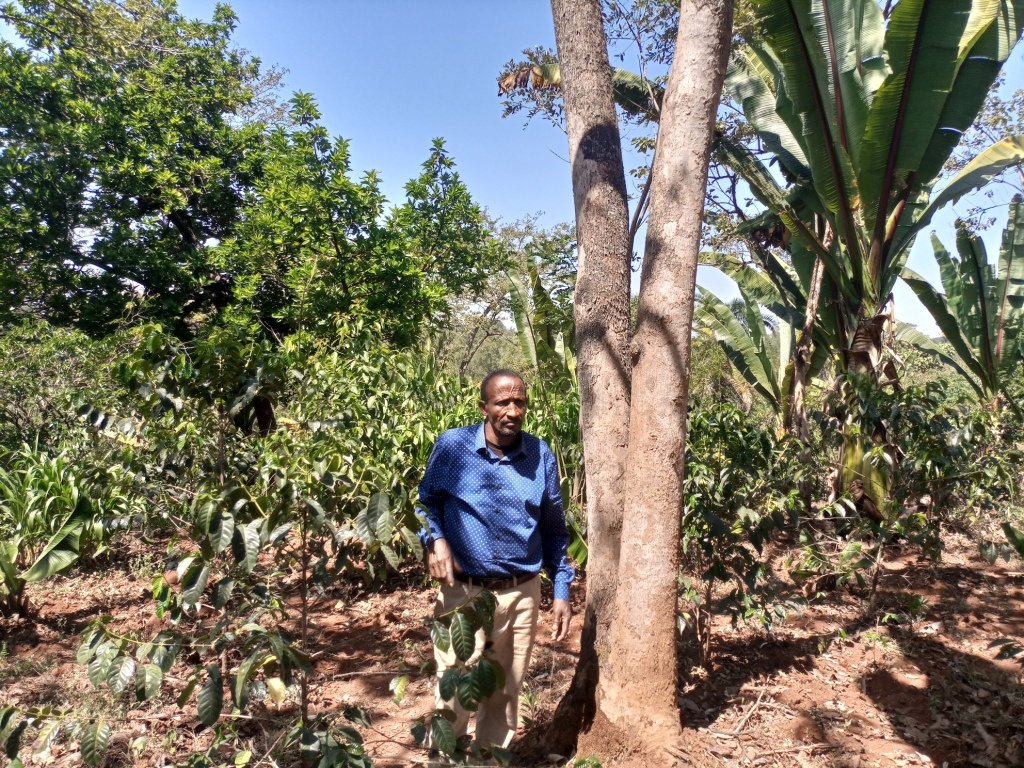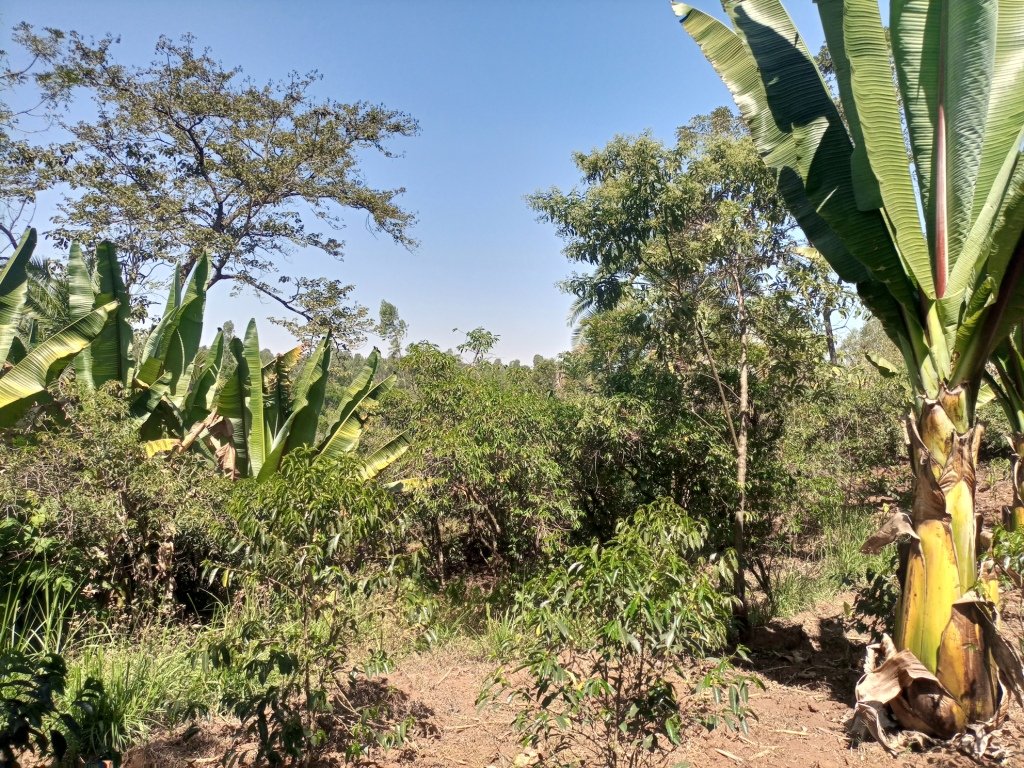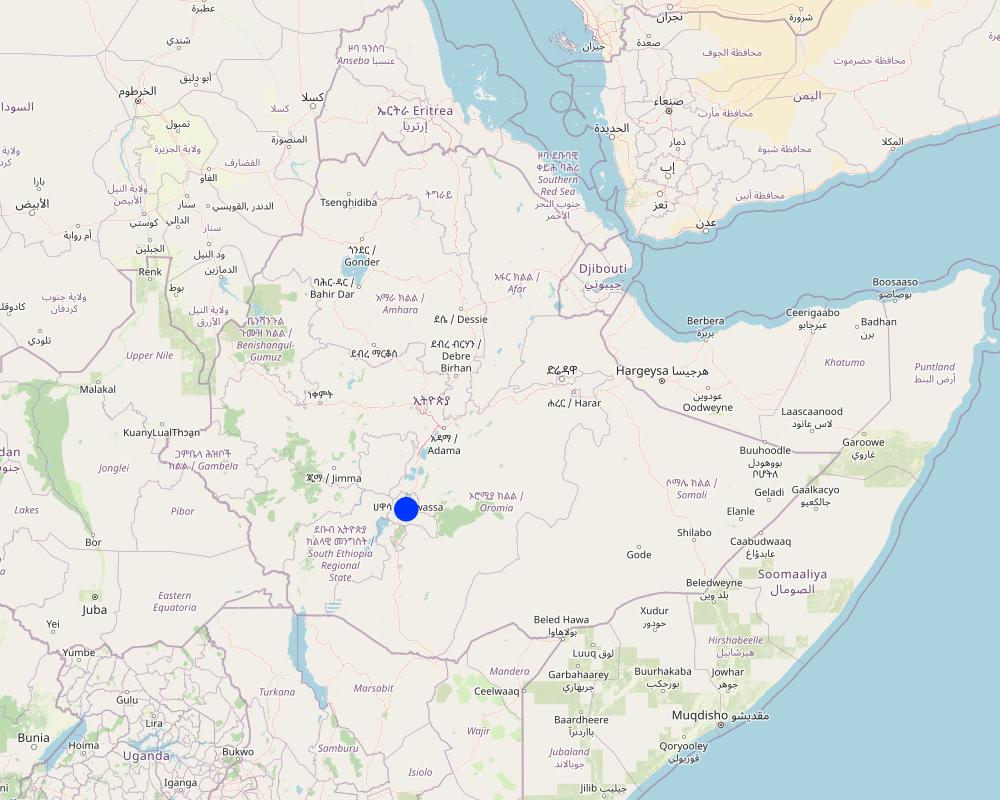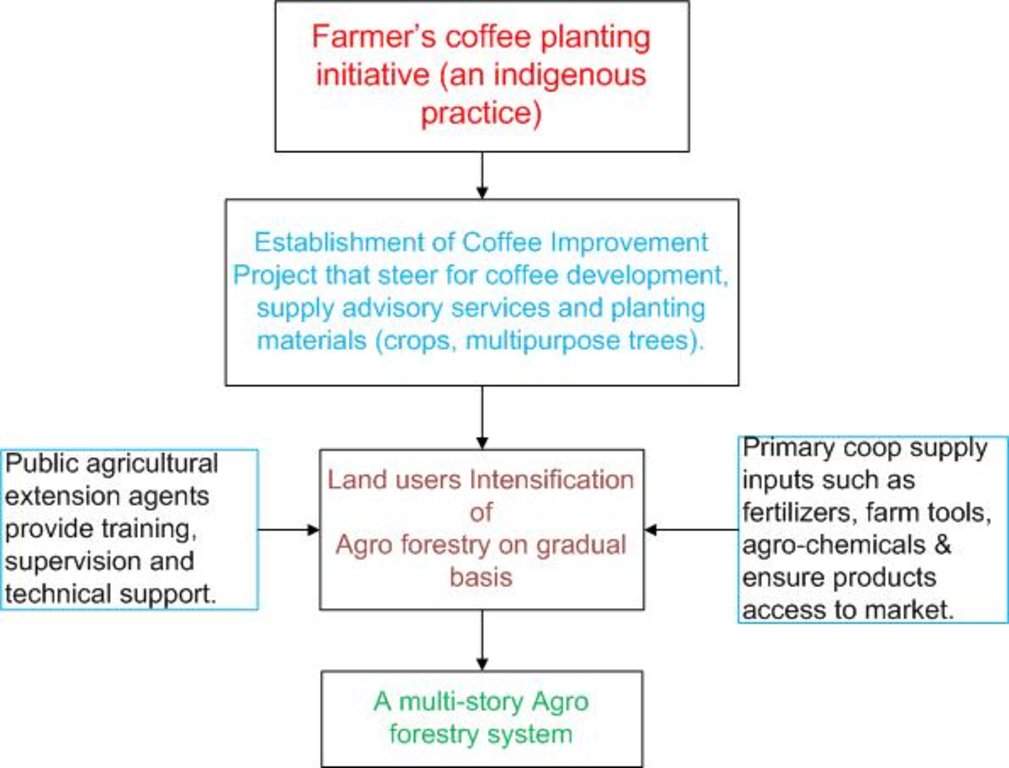Integrated Agroforestry System [Etiópia]
- Criação:
- Atualização:
- Compilador/a: GERBA LETA
- Editores: Julia Doldt, Noel Templer, Kidist Yilma, Tabitha Nekesa, Ahmadou Gaye, Siagbé Golli
- Revisores: William Critchley, Rima Mekdaschi Studer, Sally Bunning
Mitikarsamino Ersha
approaches_6622 - Etiópia
Veja as seções
Expandir tudo Recolher tudo1. Informação geral
1.2 Detalhes do contato das pessoas capacitadas e instituições envolvidas na avaliação e documentação da abordagem
Pessoa(s) capacitada(s)
usuário de terra:
Gabiba Afra
+251 934 73 5738
Farmer
Dale District, Shoye kebele Sidma Regional State Ethiopia
Etiópia
Nome do projeto que facilitou a documentação/avaliação da Abordagem (se relevante)
Soil protection and rehabilitation for food security (ProSo(i)l)Nome da(s) instituição(ões) que facilitou(ram) a documentação/avaliação da Abordagem (se relevante)
CIAT International Center for Tropical Agriculture (CIAT International Center for Tropical Agriculture) - Quênia1.3 Condições em relação ao uso da informação documentada através de WOCAT
Quando os dados foram compilados (no campo)?
13/01/2023
O compilador e a(s) pessoa(s) capacitada(s) aceitam as condições relativas ao uso de dados documentados através do WOCAT:
Sim
1.4 Referência ao(s) questionário(s) sobre tecnologias da GST
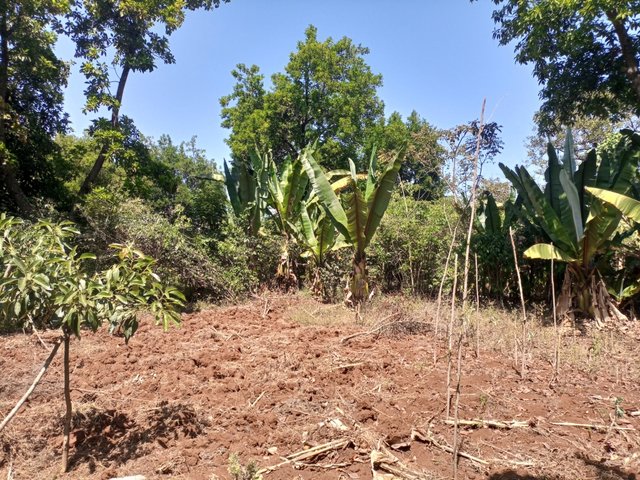
Multistorey agroforestry [Etiópia]
Multistorey agroforestry is the intentional mixing of trees/shrubs with crops, pastures, and livestock. The practice creates environmental, economic, and social benefits for the end users.
- Compilador/a: GERBA LETA
2. Descrição da abordagem de GST
2.1 Descrição curta da abordagem
The integrated agroforestry system is a self-initiated approach by a land user to implement agroforestry as part of an indigenous practice and has evolved over the years through technical support, training, and supplies of coffee and tree seedlings by the Office of Agriculture and Coffee Improvement Project. Had there been a participatory process throughout it would have helped in design and also in scaling up.
2.2 Descrição detalhada da abordagem
Descrição detalhada da abordagem:
The integrated agroforestry system was independently initiated by land users during the Derg regime (1974-91). During the regime, farmers were failed by two distinct and polar development approaches: socialist and the mainstream local approaches. The earlier one involved the communist approach of communal production and sharing the output according to contribution. The latter ones employed a conventional approach and included non-members of the so-called Farmers Producer Cooperatives. As a non-member of the earlier one, the land user had to develop his farm alone. The solitary agroforestry initiative described here has gradually evolved to a fully-fledged system that currently serves as a model SLM practice for scaling up across similar agroecological and farming system. Thus, there was little participation involved during the early intensification of agroforestry in Ethiopia. Rather, it is considered an indigenous practice that now receives publicity as a form of “regenerative agriculture” with ecological, economic, and social benefits. As it has global significance in terms of emission reduction and sequestration of carbon, it is the favourite technology among the government and other development practitioners.
The farmer started agroforestry by planting enset and coffee. Over time, with emerging technical support, access to training, and supply of coffee seedlings by the agriculture and coffee improvement project offices, the land user has continued intensification of the agroforestry around the homestead by adopting the correct planting space for coffee and enset, and other companion fruit, fodder crops, and shade trees. The former Ministry of Coffee and Tea, and the current Ministry of Agriculture have had an immense contribution by supplying technical support, training, and inputs (notably coffee and tree seedlings), and by ensuring access to fertilizers. The latter was supplied to the farmers on a credit basis through the then Service Cooperative.
As the initiative was the farmer's own, the tendency to plant incompatible crops was not uncommon. Even so, the agroforestry trees and shrubs still had immense ecological and economic value. They ameliorate the extreme temperature experienced during the dry season, improve the microclimate, recharge the surface and groundwater via improving water infiltration, and reduce runoff losses. Improving soil fertility and soil health are among other benefits. Despite the substantial benefit the technology confers on land users, the lack of a participatory approach in planning, implementation, monitoring, and evaluation at the community level restricts the adoption and scaling up of this beneficial approach. Despite the achievements of the land user, earlier engagement of other smallholders and institutionalizing the approach decades ago might have positively influenced the design as well as wider-scale adoption and application of the technology. However, regardless of any limitations, the technology is evidence-based and inspirational.
2.3 Fotos da abordagem
Observações gerais sobre as fotos:
The photo shows the practice rather than the approach. However, the existing scene is just the outcome of the approach (farmer's own) employed to establish and maintain the agroforestry practice.
2.4 Vídeos da abordagem
Comentários, breve descrição:
Videos of the approach is not documented.
2.5 País/região/locais onde a abordagem foi aplicada
País:
Etiópia
Região/Estado/Província:
Sidama
Especificação adicional de localização:
Shoye kebele (Kebele - lower administrative level).
Comentários:
As perennial crop enset (false banana) is a staple food in the area, the farming system is tree based but vary with degrees of intensification.
Map
×2.6 Datas de início e término da abordagem
Indique o ano de início:
1980
Comentários:
It is a continuous, non-ending self initiative inheritable by the generation to come.
2.7 Tipo de abordagem
- Tradicional/Indígena
2.8 Principais metas/objetivos da abordagem
A traditional approach was initiated to change the land use/ land cover and optimize the benefit of the degraded land by reducing the negative effects of overgrazing and its consequence.
2.9 Condição que propiciam ou inibem a implementação de tecnologia/tecnologias aplicada(s) segundo a abordagem
Normas e valores sociais/culturais/religiosos
- Propício
The long-standing tradition of the society promotes planting and preserving trees.
Disponibilidade/acesso a recursos e serviços financeiros
- Propício
Access to in-kind credit services such as fertilizers from farmers' cooperatives enables the land users to effectively implement the practice.
Quadro institucional
- Inibitivo
The lack of institutional setting might have influenced the rate of scaling the technology.
Colaboração/coordenção de atores
- Propício
Foster farmers access to training, technical support, exchange visit...
Quadro jurídico (posse de terra, direitos de uso da terra e da água)
- Propício
Enables the development of a sense of ownership and accountability to properly implement and manage the practice.
Conhecimento sobre GST, acesso a suporte técnico
- Propício
Promote effective implementation, management, and use of the return from the practice.
Mercados (para comprar entradas, vender produtos) e preços
- Propício
The availability of a fair and subsidized market enables the approach.
- Inibitivo
Lack of reliable market compels to change the approach to another income-generating practice/approach.
Carga de trabalho, disponibilidade de força de trabalho
- Propício
The availability of manpower enables one to accomplish the job without pressure.
- Inibitivo
Shortage of manpower disables effective implementation of the practice.
3. Participação e papel das partes interessadas envolvidas
3.1 Partes interessadas envolvidas na abordagem e seus papéis
- Usuários de terra/comunidades locais
Land users and local communities
Plan and implement the technology, and sharing labor, skills and knowledge.
- Especialistas em GST/ consultor agrícola
Development agents (DAs) and district experts
Provide training, and technical support, facilitate land users' access to inputs such as seedlings and fertilizers, monitor and evaluate, and documentation of successful practices for pervasive application and use.
- Pesquisadores
Regional Agricultural Research Institute, and under/graduate students.
Generate supportive specific and relevant technologies, learn the lesson, and recommend best-fit technologies/practices.
- Governo local
District administration and colleagues
Acknowledge the farmers/technology adopters as a model to showcase their experience and encourage the scaling out of the initiative.
3.2 Envolvimento do usuários de terra/comunidades locais nas diferentes fases da abordagem
| Envolvimento do usuários de terra/comunidades locais | Especifique quem estava envolvido e descreva as atividades | |
|---|---|---|
| Iniciação/motivação | Automobilização | Land user: Initiated coffee and enset plantation little by little and accessed training and technical support from DAs and Woreda office of Agriculture experts. |
| Planejamento | Automobilização | Land user and development agent: In consultation with DAs, the land users plan based on available labor and capital every other year. |
| Implementação | Automobilização | Land users and family member. They involved in various implementation/management activities. |
| Monitoramento/avaliação | Passivo | Government development agents, and experts coordinate mobilization of the communities to visit and learn from the ongoing practice. |
3.3 Fluxograma (se disponível)
Descrição:
A flow chart depicting the evolution of practice from self-initiative indigenous coffee planting practices to a multistorey agroforestry system with the participation and support of public organization agents and farmers' primary cooperative.
Autor:
Gerba Leta
3.4 Decisão sobre a seleção de tecnologia/tecnologias de GST
Especifique quem decidiu sobre a seleção de tecnologia/tecnologias a serem implementadas:
- Somente usuários da terra (iniciativa própria)
Explique:
The land user was the initial decision maker that later cross-fertilized or complemented by research and development actors.
Especifique em que base foram tomadas as decisões:
- Experiência pessoal e opiniões (não documentado)
4. Suporte técnico, reforço das capacidades e gestão do conhecimento
4.1 Reforço das capacidades/formação
Foi oferecida formação aos usuários da terra/outras partes interessadas?
Sim
Especifique quem foi capacitado:
- Usuários de terra
- Development agents
Caso seja relevante, especifique gênero, idade, status, etnia, etc.
Training is usually provided to literate farmers who are capable of reading, taking notes, and sharing with other peers back home. Women-headed household are inclusive to represent the gender parity.
Tipo de formação:
- Reuniões públicas
Tipo de formação:
- Training and visit
Assuntos abordados:
Coffee production and management such as preparation of planting pits, refilling the soil back to the pit, planting space, fertilizer application, weeding, mulching, planting shade trees, etc.
Comentários:
Integrating enset, shade trees, and soil bunds with productive barriers into the farm eventually evolves into the agroforestry system.
4.2 Serviço de consultoria
Os usuários de terra têm acesso a um serviço de consultoria?
Sim
Especifique se foi oferecido serviço de consultoria:
- nas áreas dos usuários da terra
- Em centros permanentes
Descreva/comentários:
The training used to be given in permanent centers such as development stations in the past and Farmers Training Center since recent a decade ago and was associated with a visit to a farmers field.
4.3 Fortalecimento da instituição (desenvolvimento organizacional)
As instituições foram fortalecidas ou estabelecidas através da abordagem?
- Não
4.4 Monitoramento e avaliação
Monitoramento e avaliação são partes da abordagem?
Não
Comentários:
A sort of visit may be organized by development agents to the coffee plantation but not in a way address the role of monitoring and evaluation and documentation.
4.5 Pesquisa
A pesquisa foi parte da abordagem?
Não
5. Financiamento e apoio material externo
5.1 Orçamento anual para o componente de GST da abordagem
Caso o orçamento exato seja desconhecido, indique a faixa:
- < 2.000
Comentários (p. ex. principais fontes de recursos/principais doadores):
Only in kind support such as coffee seedlings and technical support such as advisory service was provide by the government agricultural office through development/extension agents. Otherwise, it is privately financed business with main expense geared toward supplying seedlings and agricultural inputs such as fertilizers.
5.2 Apoio financeiro/material concedido aos usuários da terra
Os usuários da terra receberam apoio financeiro/material para a implementação de tecnologia/tecnologias?
Sim
Caso afirmativo, especifique tipo(s) de apoio, condições e fornecedor(es):
In the past (during Derg regime) there was subsidy for fertilizers as a country which is entirely removed in the recent years.
5.3 Subsídios para entradas específicas (incluindo mão-de-obra)
- Outro
| Outros (especifique) | Em que medida | Especifique os subsídios |
|---|---|---|
| Fertilizer | Parcialmente financiado | In the past, the government import and supply fertilizer on subsidized basis. The trend was changed over the last a couple of decades. |
Se a mão-de-obra pelos usuários da terra foi uma entrada substancial, isso foi:
- Voluntário
Comentários:
Family labor used to manage the family farm.
5.4 Crédito
Foi concedido crédito segundo a abordagem para atividades de GST?
Não
5.5 Outros incentivos ou instrumentos
Foram utilizados outros incentivos ou instrumentos para promover a implementação das tecnologias de GST?
Não
6. Análise de impactos e declarações finais
6.1 Impactos da abordagem
A abordagem concedeu autonomia aos usuários locais de terra, melhorou a participação das partes interessadas?
- Não
- Sim, pouco
- Sim, moderadamente
- Sim, significativamente
The approach was mainly based on self initiative. The assistance that came in later on was top-down where farmers were urged to plant coffee and companion tree crops. However, later it has evolved into agroforestry and SLM that empower local land users to join.
A abordagem propiciou a tomada de decisão baseada em evidências?
- Não
- Sim, pouco
- Sim, moderadamente
- Sim, significativamente
It is not entirely the approach but the outcome of intensifying the technology that eventually enables land users and other stakeholders to make an evidence-based decision.
A abordagem auxiliou os usuários da terra a implementar e manter as tecnologias de GST?
- Não
- Sim, pouco
- Sim, moderadamente
- Sim, significativamente
The prevailing system compels farmers to integrate land management practices such as soil bunds, food and non-food tree species into the farm that enable land users to adopt and uphold SLM technology.
A abordagem melhorou a coordenação e a implementação economicamente eficiente da GST?
- Não
- Sim, pouco
- Sim, moderadamente
- Sim, significativamente
A abordagem mobilizou/melhorou o acesso aos recursos financeiros para implementação da GST?
- Não
- Sim, pouco
- Sim, moderadamente
- Sim, significativamente
,
A abordagem aprimorou o conhecimento e as capacidades dos usuários da terra para implementar a GST?
- Não
- Sim, pouco
- Sim, moderadamente
- Sim, significativamente
Through public meetings and social learning from peers and better-off farmers, land users' knowledge and skills to implement the technology have been improved.
A abordagem aprimorou o conhecimento e as capacidades de outras partes interessadas?
- Não
- Sim, pouco
- Sim, moderadamente
- Sim, significativamente
Virtually through social learning and labor sharing.
A abordagem construiu/fortaleceu instituições, colaboração entre partes interessadas?
- Não
- Sim, pouco
- Sim, moderadamente
- Sim, significativamente
It was a solitary approach but later adopted by numerous land users.
A abordagem atenuou conflitos?
- Não
- Sim, pouco
- Sim, moderadamente
- Sim, significativamente
A abordagem concedeu autonomia aos grupos social e economicamente desfavorecidos?
- Não
- Sim, pouco
- Sim, moderadamente
- Sim, significativamente
It doesn't deliberate about gender disparity and equity as it was an indigenous initiative in the long past.
A abordagem melhorou a igualdade de gêneros e concedeu autonomia a mulheres e meninas?
- Não
- Sim, pouco
- Sim, moderadamente
- Sim, significativamente
A abordagem encorajou os jovens/as próximas gerações de usuários de terra a se envolverem na GST?
- Não
- Sim, pouco
- Sim, moderadamente
- Sim, significativamente
The established technology built youths trust in SLM.
A abordagem melhorou as questões de posse de terra/diretos do usuário que inibiam a implementação das tecnologias de GST?
- Não
- Sim, pouco
- Sim, moderadamente
- Sim, significativamente
A abordagem resultou em segurança alimentar aprimorada/nutrição melhorada?
- Não
- Sim, pouco
- Sim, moderadamente
- Sim, significativamente
Actually, implementing the agroforestry improved food and nutrition security of the family farmers.
A abordagem melhorou o acesso aos mercados?
- Não
- Sim, pouco
- Sim, moderadamente
- Sim, significativamente
Harvest from the integrated system improved farmer's access to market.
A abordagem resultou em acesso melhorado à água e ao saneamento?
- Não
- Sim, pouco
- Sim, moderadamente
- Sim, significativamente
A abordagem resultou em uso/fontes de energia mais sustentável?
- Não
- Sim, pouco
- Sim, moderadamente
- Sim, significativamente
Through promoting biogas technology in mixed tree-crop-livestock system.
A abordagem aprimorou a capacidade dos usuários da terra de adaptar-se a mudanças climáticas/extremos e atenuar os desastres relacionados com o clima?
- Não
- Sim, pouco
- Sim, moderadamente
- Sim, significativamente
Again, it is not the approach but the applied technology has improved farmers adaptation to climate change/climate variability.
A abordagem resultou em emprego, oportunidades de renda?
- Não
- Sim, pouco
- Sim, moderadamente
- Sim, significativamente
It creates all year round employment opportunity for family labor and other casual laborers.
6.2 Principal motivação dos usuários da terra para implementar a GST
- Produção aumentada
Improve crop production and productivity; diversify crops and reduces risks of crop failure; improved soil fertility and reduce runoff.
- Lucro (lucrabilidade) aumentado, melhora da relação custo-benefício
Land users managed to generate income from the sale of cash crops such as coffee, and fruits as compared to the investment in managing the system.
- Degradação do solo reduzida
Permanent land cover by trees, shrubs, and perennial food, cash, and fodder crops reduces land degradation. Also, enrich the land with litter and organic matter.
- Riscos de desastre reduzido
Reduce the risk of flood and soil runoff, diversify crops and reduce the risk of failure owning to climate change/variability.
- Prestígio, pressão social/coesão social
Land user becoming the richest in the community implies earning from the investment makes her/his prestigious within the community.
- Consciência ambiental
The reduction of adverse effects due to the implementation of the technology allows for an increase in environmental consciousness.
- melhoria dos conhecimentos e aptidões de GST
6.3 Atividades de sustentabilidade de abordagem
Os usuários da terra podem manter o que foi implementado através da abordagem (sem apoio externo)?
- Sim
Caso afirmativo, descreva como:
Despite the implementation approach employed by the land user, the technology is highly commended by the land users and the public at large. The income generated from the sale of crops adequately supports the livelihoods of family farmers as well as effectively finances the maintenance of the system. However, the new beginners need external support to make sure the technology is properly implemented and scaled out for wider application and use.
6.4 Pontos fortes/vantagens da abordagem
| Pontos fortes/vantagens/oportunidades na visão do usuário da terra |
|---|
| Enables improved crop production and productivity and reduces risks of crop failure due to climate change/variability. |
| Motivate farmers to reduce soil erosion and land degradation and improve soil fertility. |
| The approach creates an enabling environment to intensify agroforestry and improve the microclimate of the area and ensure sustainability of the system. |
| Increased land users' status in the community to feel confident as local elites and friendliness to the environment. |
| Pontos fortes/vantagens/oportunidades na visão do compilador ou de outra pessoa capacitada |
|---|
| The agroforestry system creates economic, ecological, and social benefits for the family farm. |
| It ensures sustainable land management becomes in place as well as improves land users' understanding of SLM. |
| Ensure productivity and product stability, and serve as a permanent source of income and insurance for a family farmer. |
6.5 Pontos fracos, desvantagens da tecnologia e formas de superá-los
| Pontos fracos/desvantagens/riscos na visão do usuário da terra | Como eles podem ser superados? |
|---|---|
| Failure to promote collective action that end up with shortage of labor with increasing size/ areas of technology. | Establish and promote collective action and labor-sharing techniques. |
| Lack of participatory planning and decision make to put in place proper trees-crops integration. | Promote participation that enables to select and plant trees and crops with desirable characteristics to the agroforestry system. |
| Lack of active women participation with clear role and their share of the benefit from the system. | Improve women's participation and share of the benefit. |
| Pontos fracos/vantagens/riscos na visão do compilador ou de outra pessoa capacitada | Como eles podem ser superados? |
|---|---|
| Lower level of mainstreaming the approach and the technology at earlier stage that led to land users lower level of understanding of the multi-storey agroforestry system. | Improve land users understanding of Agroforestry and the SLM through capacity building and exchange visits. |
| The solitary approach led to relatively lower adoption of the technology. | Improve participation, access to training, technical support, and credit services to optimize the benefit of land users at scale. |
| Evolving the approach from solitary approach to large mass of land users constrained by shortage of farmland. | Promote intensification through introduction of high - value crops and optimize the return from the smaller holdings. |
7. Referências e links
7.1 Métodos/fontes de informação
- visitas de campo, pesquisas de campo
3
- entrevistas com usuários de terras
One land user
- entrevistas com especialistas em GST
2
7.2 Referências às publicações disponíveis
Título, autor, ano, ISBN:
An Agroforestry Guide for Field Practitioners. 2013. ISBN 978-92-9059-333-1
Disponível de onde? Custos?
https://www.worldagroforestry.org
7.3 Links para informação relevante que está disponível online
Título/ descrição:
SUSTAINABLE LAND USE FORUM
URL:
http://publication.eiar.gov.et
Links e módulos
Expandir tudo Recolher tudoLinks

Multistorey agroforestry [Etiópia]
Multistorey agroforestry is the intentional mixing of trees/shrubs with crops, pastures, and livestock. The practice creates environmental, economic, and social benefits for the end users.
- Compilador/a: GERBA LETA
Módulos
Não há módulos


